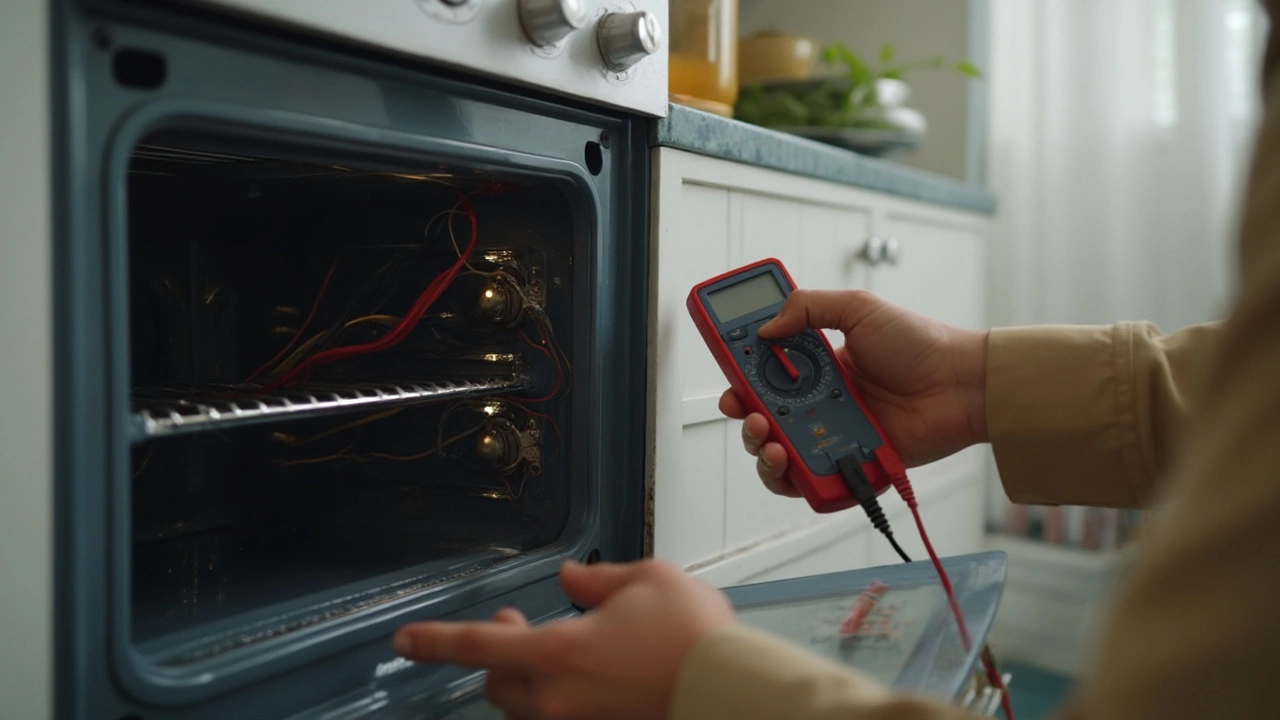Electric oven on the fritz? It's enough to ruin dinner plans—and your mood. Most of the time though, these things can be fixed. In fact, lots of the problems people freak out about are pretty common and not nearly as expensive to solve as you might think.
If your oven won’t heat up or the inside light’s out, don’t panic just yet. Ovens are surprisingly simple machines. Many issues come from stuff like a busted heating element, broken knobs, or just a tripped circuit breaker. You don’t need fancy tools or an engineering degree for basic troubleshooting—just a bit of patience and a screwdriver.
Before ditching your oven for a new one, stick with me. There’s a good chance you’ll save a lot of money just by knowing what usually goes wrong and what you can try yourself. And if you’re not the ‘fix it yourself’ type, you’ll know exactly what to ask a repair tech. Let’s see what’s really fixable—and when it’s time to call in the cavalry.
- Common Breakdowns: What's Usually Wrong?
- DIY Fixes Anyone Can Try
- When to Call a Pro
- Parts Worth Replacing
- Cost vs. Value: Is It Worth Repairing?
- Keeping Your Oven Running Longer
Common Breakdowns: What's Usually Wrong?
Most of the time, problems with your electric oven come down to a handful of usual suspects. The most common breakdowns aren’t anything wild—they’re pretty predictable. Here’s what’s often at play:
- Heating Elements Burning Out: If your oven won’t heat up, odds are the bake or broil element has failed. These are the thick metal rods in the top or bottom that glow red-hot. If they look cracked, blistered, or have obvious breaks, that’s your culprit.
- Faulty Temperature Sensor: Sometimes, an oven turns on but never reaches the right temperature. A broken sensor can give false readings so the control board thinks it’s hotter (or colder) than it really is.
- Broken Door Latch or Hinges: Modern ovens with self-cleaning cycles need a tight seal. If your latch or hinges are busted, your oven might not start at all, or heat keeps leaking out.
- Malfunctioning Control Board or Touchpad: If nothing happens when you press the buttons, the control board or touchpad could be fried. Sometimes it’s a worn-out connection, not the whole board.
- Blown Thermal Fuse or Tripped Circuit Breaker: Ovens have safety fuses inside. Surge or overheating, and they blow—shutting everything down. It’s not unusual, especially after a storm or a kitchen mishap.
- Bad Wiring or Loose Connections: Constant slamming of the oven door or hauling it around for cleaning can loosen internal wires. If you’re hearing buzzing, experiencing random shut-offs, or smelling something electrical, this might be your problem.
Here’s a quick look at how common certain issues are with electric ovens, based on recent U.S. consumer repair data:
| Issue | % of Cases Reported |
|---|---|
| Heating Element Failure | 41% |
| Door/Hinge Problems | 22% |
| Control Board Failure | 18% |
| Faulty Thermal Fuse | 10% |
| Sensor or Thermostat Malfunction | 9% |
Most breakdowns stem from heavy use, age, or just a quirk with a particular brand or model. If your stove’s 10+ years old, don’t be surprised if things start to go. But here’s the good news—most of these problems can be diagnosed and tackled without tossing your entire oven.
DIY Fixes Anyone Can Try
Before you start taking apart your electric oven, always unplug it or flip the breaker—safety first, right? You don’t want a zap while trying to play repair tech.
Now, let’s talk about the quick wins. Some problems have super simple solutions—no fancy skills required. Here are a few electric oven repair moves almost anyone can pull off:
- Oven won’t heat? Check if the circuit breaker has tripped. Reset it if needed. If you just moved the oven, make sure it’s plugged in tight.
- Heating element looks rough? Open the oven and inspect both the top (broil) and bottom (bake) elements. Burn marks or visible breaks? No problem—most heating elements just screw or slide out after you remove a few screws and unplug a wire or two. Replacement parts are easy to find online.
- Oven light won’t turn on? Sometimes it’s just the bulb. Unscrew the cover (usually inside the oven), and swap in a new oven-rated bulb. If it still won't light, check the socket for visible damage or corrosion.
- Temperature seems off? A cheap oven thermometer (less than $10 at any hardware store) can tell you if your temperature knob is lying. If it’s way off, consider recalibrating the oven—some models have a screw behind the knob for this.
- Self-clean not working? Many ovens lock the door during the clean cycle. If the door won’t unlock after the cycle, unplug the oven for a minute. Often, this resets the lock.
Here’s a quick breakdown of replacement part costs for the most common fixes:
| Part | Avg. Cost (USD) |
|---|---|
| Heating Element | $20–$50 |
| Oven Light Bulb | $3–$10 |
| Temperature Sensor | $15–$40 |
| Control Knob | $8–$20 |
Keep in mind, most fixing ovens at home doesn't void warranties as long as you're just swapping parts, but check your owner’s manual just in case. If you run into melted wires, burning smells, or control panel glitches, quit right there and call a pro—some things aren’t worth risking a fire for!
When to Call a Pro
Troubleshooting an electric oven repair is great—up to a point. But not every problem is worth fighting with a YouTube video and a wrench. Some issues are downright risky, and a pro has the tools and know-how to keep things safe (and get the hot meals flowing again).
Here’s when you should step back and let a professional handle it:
- Electrical Shortages or Burning Smells: If you ever see sparks, smell burning plastic, or your oven keeps tripping the breaker, it’s time to call an expert. Oven wiring can go bad, and mistakes here can lead to fires.
- Main Electronic Board Is Dead: If your oven won’t turn on and you’ve already checked the breaker and outlets, the control board might be fried. Swapping this out isn’t like changing a light bulb. A tech has the skills (and replacement parts) to do it right.
- Replacing the Heating Element (in Wall Ovens): Plug-in ranges make this somewhat easy, but built-in wall ovens usually require the whole unit pulled out. Doing this wrong can smash connections or crack the glass. Spare your back—call for help.
- Oven Door Won’t Shut or Glass Is Broken: That’s not just annoying, it’s dangerous. Glass doors are under pressure and can shatter if you don’t handle them right. Let a pro deal with this one.
- Issues with Digital Displays or Beeping: If buttons stop working, the display blinks random codes, or your oven keeps beeping and won’t cook, it’s usually a control board or sensor issue. These are tricky and some models need special tools for diagnosis and repair.
Maybe you’re wondering about costs and if a fixing ovens pro is worth it. On average, repair calls for electric ovens run $150–$400, depending on the part (according to a 2023 HomeAdvisor survey). The repair usually beats the price of a new oven, which easily slips over $600 for basic models.
| Common Repair | Average Cost (USD) | Worth Fixing? |
|---|---|---|
| Heating Element Replacement | $120 - $250 | Yes |
| Control Board Repair | $200 - $400 | Usually |
| Oven Door or Glass Fix | $180 - $350 | Yes |
| Internal Wiring Fix | $100 - $220 | Yes, if oven is under 10 years old |
There’s no shame in calling for help—some parts of oven troubleshooting just need a pro. If in doubt, better safe than sorry. And hey, you might even get the oven deep-cleaned while they’re at it.

Parts Worth Replacing
When your electric oven repair journey starts, knowing which parts are worth fixing could save you a bundle. Most ovens break down because of a handful of usual suspects. These parts wear out from regular use, so swapping them out can give your oven a new lease on life without breaking the bank.
The most common parts to replace are:
- Heating Elements: If your oven's not getting hot enough or doesn’t heat at all, it's probably the bake or broil element. Replacing these is often cheaper than a service call.
- Thermostat or Temperature Sensor: Burnt cookies or food that never cooks through? These sensors tell your oven how hot it is inside. They're small and usually easy to swap out.
- Door Gasket: If heat leaks out around the door, your oven won’t keep steady temps. Gaskets are cheap and simple to replace.
- Knobs and Control Boards: Sometimes it’s just a faulty dial or a misbehaving control board. Dials pop right off; control boards take a screwdriver and patience.
- Light Bulbs and Sockets: Not exactly exciting, but seeing your food cook is underrated. Replacement bulbs are a snap, and sockets are straightforward for most folks with basic tools.
Here's a quick peek at what you might spend (parts only, excludes labor):
| Oven Part | Typical Replacement Cost (USD) |
|---|---|
| Heating Element | $25 - $65 |
| Temperature Sensor | $20 - $50 |
| Door Gasket | $10 - $40 |
| Control Board | $100 - $300 |
| Oven Light Bulb | $2 - $15 |
Swapping simple stuff like a bulb, gasket, or even a heating element is usually a solid DIY move for everyday oven troubleshooting. If you get into wiring, like on the control board or sensors, read up and make sure the oven’s unplugged—safety first. And if you try these fixes and nothing changes, that’s when it makes sense to call in a pro. But for most fixing ovens jobs, you’re looking at parts that are easy to get and not too complicated to replace.
Cost vs. Value: Is It Worth Repairing?
Here's the million-dollar question: should you fix your electric oven or buy a new one? There’s no magic answer, but I’ll break it down in a way that makes sense before you throw your cash away.
Fixing a basic issue like a heating element might cost under $100 if you do it yourself. Even hiring a repair pro for simple electric oven jobs usually runs $150–$300, which is way cheaper than dropping $600–$2500 on a new oven. But if the repair bill starts creeping toward 50% of a new oven’s cost, that’s when you need to think twice. Appliance pros use that as a rule of thumb: if repairs cost more than half the price of a new oven, replacement starts to look smarter.
Older ovens—over 10-12 years—also become less worth fixing. Parts get harder to find, and newer ovens are often more energy-efficient. Still, if your oven’s a workhorse and hasn’t caused trouble until now, a single repair can sometimes buy you a few more solid years.
Here’s a quick price rundown to help you weigh your options:
| Repair Needed | Typical Cost (Parts + Labor) |
|---|---|
| Heating Element Replacement | $90–$250 |
| Thermostat Repair | $120–$225 |
| Control Board Replacement | $200–$400 |
| Door Seal/Gasket | $50–$100 |
| Whole-Oven Replacement | $600–$2500 |
Think about age, frequency of trouble, and energy costs. If your electric oven always acts up, or repair after repair keeps adding up, maybe it’s time to call it quits. But for a one-off fix and solid track record, repairing is usually the smart move.
Final tip: ask about warranty on repairs. Most pros guarantee the work for 30-90 days. If your oven dies again within that window, you might get a free follow-up visit. A little knowledge stretches your dollar way further than tossing the oven out at the first sign of trouble.
Keeping Your Oven Running Longer
If you want your electric oven to last more than a handful of years, you need more than luck. Regular upkeep makes all the difference. Here’s what actually works, based on what appliance techs see every week.
- Keep it clean. Food gunk and grease cause big problems down the road. Try to wipe up spills after every use, especially those that drip to the bottom. Each month, do a proper clean with a non-abrasive cleaner and a soft cloth. Skip harsh chemicals if your oven has a self-cleaning function—those can mess with sensors.
- Check the door seal. If the oven door doesn’t seal tight, heat escapes and your food cooks unevenly. Cracked or loose gaskets are easy to spot—and cheap to replace. Not fixing it means your electric oven has to work harder, which shortens its life.
- Don’t slam the door. Sounds basic, but a lot of oven repairs come from rough handling. Hinges and the glass panel inside the door can break from being slammed shut.
- Inspect the heating elements. Give the elements a quick look each month—especially if you rely on your oven daily. Warped or burnt-out spots are red flags. If they’re damaged, swap them out before they ruin a big meal.
- Watch the vents. Those little holes or strips along the oven frame aren’t just for show. Blocked vents mean your oven overheats—which triggers shutoffs or damages the electrics. Keep them clear of foil and food wrappers.
Here’s a quick look at what regular care can do for electric oven repair costs:
| Care Habit | Estimated Repair Savings (yearly) |
|---|---|
| Monthly deep cleaning | $50–$120 |
| Replacing door gasket when worn | $80–$200 |
| Quick fix for vent blockages | $40–$100 |
It’s not rocket science—just a bit of effort between pizza nights. These simple steps mean fewer calls to repair techs, less downtime, and probably fresher meals. Your wallet—and your food—will thank you.



